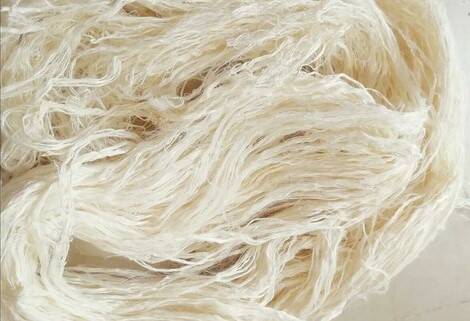Ramie is a wonderful natural substance. A linen-like fabric that falls under the cellulose fibers, or natural plant fibers. Made from the bark of the Chinese nettle. Ramie is an eco-friendly fabric that is very durable compared to cotton or man-made (synthetic) fibres. The plant is naturally fungicidal and has few problems with insects, so pesticides and chemicals are not necessary. This makes it an environmentally friendly and ecological crop. Ramie is also known as ramee, Chinese linen, Chinese grass linen and Rhae.
What is ramie fabric?
The plantbased ramie fiber is known for its length and strength. Ramie fibers are softer and whiter than linen. The organic fiber has a long history of use for textiles and (industrial) products such as rope, fishing nets and paper.
The stems yield a durable, pure white, glossy fiber. The longest and strongest of any known plant fiber, said to be up to eight times stronger than cotton. It can quickly absorb and release moisture, making it very suitable for (summer) clothing.
However, it is difficult to remove the sticky gum that surrounds the fiber, which means that it remains a small-scale fiber production. It does wrinkle, but not as fast as linen. Chinese growers of traditional fiber crops such as ramie and hemp process the fabric almost entirely by hand. The price of the fabric is therefore mainly in the labor costs. This makes ramie slightly more expensive than linen.
Ramie fabric is not resilient or stretchy in itself, but it has a great advantage: it is strong and it does not shrink. This makes it not only suitable for dresses, trousers and jackets, but also for bags and other accessories such as hair bows or a scarf.

100% ramie, natural and organic
New Angels uses 100% ramie. So it's not mixed with any other kind of fiber, it's pure ramie. New Angels has opted for a woven fabric with a matte, stonewashed finish. The advantage of 100% ramie fabric is that it can be washed and ironed at a warmer temperature without shrinking or losing its shape.

Ramie plant: Boehmeria nivea
Boehmeria nivea
Ramie (Boehmeria nivea) or Chinese grass is a fiber-producing plant native to India and Southeast Asia, whose natural range extends from the foothills of the Himalayas, through Myanmar (Burma), to Cambodia, Vietnam and China. It is a shrub consisting of slender, erect, unbranched stems up to 2.5 m high. The plant is related to the nettle, but without the stinging leaves.
Boehmeria nivea is the most common plant species from which the ramie yarn is spun, and this is made from the stems of the plant, not the leaves.
White and green ramie
There are 2 types of ramie: white ramie and green ramie. White ramie is the most common ramie fabric, made from Chinese grass, the Boehmeria nivea. The leaves are heart-shaped and the underside is white and has small hairs that give it a silvery appearance. These hairs, unlike other nettles, do not sting. White ramie is naturally white, so it does not need to be bleached.
Green ramie is the second kind of ramie, also called Rhea. This species is native to Malay Peninsula, Southeast Asia. The leaves are narrower and green on the underside. This plant grows better in the tropics.

Ramie fibre
Ramie fiber and cellulose
Ramie is a natural plant fiber (cellulose). What is Cellulose? Cellulose is a major component of plant cell walls. A cellulose fiber is a fiber that is peculiar to almost all plants, but is especially associated with trees. Wood mainly consists of cellulose. Cellulose has the characteristic of absorbing moisture without rapidly changing its properties. This makes the fibers extremely suitable for clothing.
The production process: this is how you make fabric from a ramie plant
The ramie plant grows quickly. Just before flowering is the best time to harvest, because then the plant provides the most fiber. The fibers are located around the core of the stem. The plant is harvested by cutting the stems just above the lateral roots. After that, the bark can be stripped. The bark of the stems is removed when the plant is still fresh. This is usually done on site, as once the plant has dried, debarking becomes more difficult. The ribbons of bark are then dried as quickly as possible to prevent bacteria or fungi from entering.
After the ramie ribbons have dried, 'roten' and turning follow. Roten is exposing the flax stalks to water to release the fibers that can be used to produce the ramie. Roten used to be done in rivers, nowadays a more ecologically responsible way of roten is chosen: by spreading the ramie out over a field, where it also becomes moist due to exposure to rain.

Then the fibers are separated from the straw. This process is also known as scutching and hackling.
After sorting, short fibers can be used to make rope, long fibers are used to make ramie textiles. By spinning, the individual fibers are connected to each other. The long or short fibers are removed, so that an even whole is created.
The ramie ribbons are spun into yarn with a spinning machine. This is the time when the yarns are checked for firmness, suppleness and evenness. Does the material comply? Then the weaving of the fabric begins.
Ramie is naturally white, and can be dyed any color. The weaving can be coarse or fine, giving you a linen look or a silk look. Ramie is also often mixed with another fiber, such as cotton.
Ramie or ramee falls very well within slow fashion, because it is a durable fabric that is mainly used by small(er) fashion brands. It is a luxurious fabric that is natural and eco-friendly. And as an added benefit, ramie clothing gets softer the more you wash it.
Were you already familiar with the ramie fabrics? What is your experience with ramie clothing?
Lots of love,
Ingrid


Reactie plaatsen
Reacties